TURQUOISE


 Mineral characteristic.
Mineral characteristic.
For this group of very relevant question, how to distinguish a fake from and synthetics.
Compound water and aluminum phosphate. Chemical composition unstable. Chemical composition: CuO - 9.57%, Al2O3 - 36,84%, Pb2O3 - 34,12%, H2O - 19,47%. Usual weight of microcrystalline kidney-shaped or in the form of crusts, veins and irregular-shaped clusters. Constant impurities -. Sulfur, zinc, barium, chromium, nickel, titanium, etc. Blue turquoise color is characteristic of intact weathering turquoise depends on the copper content. In the aging process and the replacement part is amplified secondary minerals iron oxide, silica, calcium, magnesium, zinc, strontium, resulting turquoise greens. Greenish, brownish, and other tones caused iron oxide, copper substitute. Impurities halloysite, kaolinite and vavellita give whitish spots. Most turquoise contains inclusions of quartz, pyrite and other minerals, and often has white inclusions. Turquoise is easily processed.
Turquoise - a very hygroscopic material. Products made of it should be protected from sudden changes in temperature, heat from exposure to acids, abrasives and fumes, they can not be cleaned in soapy water. The most valuable is considered blue turquoise. Minerals turquoise crossed brown and black veins, as well as turquoise yellow-green color have lower gem quality, and therefore are sold cheaper natural sky blue. The best in the world recognized field in Iran and Arizona. In other fields weathered turquoise paler and less dense with depth observed significantly more dense and brightly colored difference between the blue and greenish tones (the higher iron oxides, the greener the turquoise). Variety of turquoise with fine veins of black carbonaceous material or iron oxides with a blue tone called spider or reticular and sell expensive.
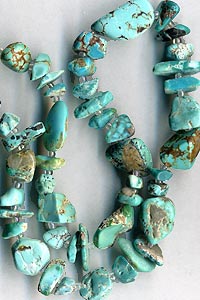 Turquoise - one of the most beautiful gemstones known to mankind since ancient times. Jewellery and charms of turquoise found during excavations of the ancient cultures of Central America, Egypt, Central Asia. In the Muslim world, especially turquoise enjoyed great love and popularity. The turquoise jewelry is usually applied in the form of cabochons, often irregular in shape, it blends well with other jewels as well as silver and gold. In ancient times, turquoise did not recover in gold, because it was believed that she was at the same time losing its beauty. Find the application and thin plates of turquoise - for inlays for metal, wood and other materials.
Turquoise - one of the most beautiful gemstones known to mankind since ancient times. Jewellery and charms of turquoise found during excavations of the ancient cultures of Central America, Egypt, Central Asia. In the Muslim world, especially turquoise enjoyed great love and popularity. The turquoise jewelry is usually applied in the form of cabochons, often irregular in shape, it blends well with other jewels as well as silver and gold. In ancient times, turquoise did not recover in gold, because it was believed that she was at the same time losing its beauty. Find the application and thin plates of turquoise - for inlays for metal, wood and other materials.
Typically, turquoise is a micro and cryptocrystalline aggregate having veins, forming nodules, the inclusion of irregular shape, smears, kidney-shaped formation. In the form of crystals, it is extremely rare (size of individual crystals of turquoise were 0.3 mm or less). Turquoise is opaque, translucent in thin cleavages. Painting it in the samples, the composition of which is close to the theoretical, bright, sky-blue. But quite often bluish color of turquoise and apple-green, sometimes greenish-brown. Turquoise may discolour in the sun. Turquoise Glitter glass or wax. Deposits of turquoise associated with weathering crusts of rocks containing mednosulfidnuyu mineralization.
Deposits of turquoise in the CIS-known in Central Asia Kurama and Kyzylkum (biryuzonosnyh areas. Turquoise in Central Asia was mined since ancient times, as evidenced by numerous ancient mines. Central Asian turquoise occurs as veinlets, nodules, lenses, phenocrysts, incorrect selections. Color it is extremely diverse, and bluish sky-blue with all the transitions in the green, brownish-green and brown Manifestations turquoise found in Azerbaijan and Georgia, the high quality of the turquoise from ancient times to the present day is produced in Iran, north-west of the city.. Nishapur. turquoise is removed manually. The largest deposits are located in the US states of Arizona, Colorado, Nevada, New Mexico. There are deposits of turquoise in Chile, Peru, Mexico, China, Australia.
Turquoise: natural color is always more expensive than their artificially colored or artificial (even blue) analogues of natural turquoise jewelry reserves are being depleted, so it will only get more expensive over time. Turquoise is always in high demand, so it is often counterfeited. Green turquoise is 3 times cheaper than the blue. On the world market 60% arrives in turquoise ennobled form, in particular ennobled about 80% of the US Arizona turquoise. Diagnosis turquoise very complicated because not only the presence of synthetic and treated stones, but also with the use of a huge number of simulations.

 Turquoise never occurs in the form of solid lumps or masses. Large pieces often speak of imitation. Today, turquoise is often ennobled - its color in solid color colored wax impregnating the upper layer. This turquoise is somewhat more resistant to external influences. The porous surface of the low-quality turquoise is impregnated with dyes. Also impregnated crushed to a powder or very small pieces and compressed under high pressure turquoise (the best imitation, and used in jewelry).
Turquoise never occurs in the form of solid lumps or masses. Large pieces often speak of imitation. Today, turquoise is often ennobled - its color in solid color colored wax impregnating the upper layer. This turquoise is somewhat more resistant to external influences. The porous surface of the low-quality turquoise is impregnated with dyes. Also impregnated crushed to a powder or very small pieces and compressed under high pressure turquoise (the best imitation, and used in jewelry).
Currently, widespread synthetic turquoise (pictured right, is quite close to the natural composition, usually bright blue with spider veins or whitish patches) and imitation turquoise, turquoise is 80% of the market. Vienna turquoise (pictured left) - thermally treated and compressed mixture of malachite, aluminum hydroxide and phosphoric acid. Turquoise called Neolithic - copper phosphate and aluminum hydroxide. In such a synthetic turquoise it appears bright and even a greenish-yellow color, uncharacteristic of natural turquoise. When heated, it becomes black, and does not crack. The synthetic material is very homogeneous, contains mikrovkrapleniya colored or whitish particles. When such a synthetic turquoise socks is good, that it never loses its color and not wiped.
Turquoise is often counterfeited plastic (when heated melts and characteristic smells, it is not porous) surface staining of bone and similar materials (inside the bone white, way separation is the ability of organic matter to burn), glass and porcelain, painting chalcedony, low-grade lapis lazuli, Cowley ., etc. There are also imitations of calcined gypsum and plaster and painted surface of gray-white natural mineral golita (kaulita) - today is the most popular and most believable fake to the uninitiated eye imitation. A distinctive feature of the simulation of soft kaulita is the rapid attrition of top dyed layer, this imitation when wearing very quickly becomes greyish and whitish, loses its presentation and is the worst.
The magical properties of stones.
There is a prejudice that would be turquoise green supposedly "old and poor", and the blue of her younger and better. It is not true. Turquoise blue, turquoise and green color is exactly the same age. Turquoise deep green color and is very expensive, but in contrast to the blue color of its more stable. The color turquoise characterized by the presence of impurities. Turquoise really may eventually or from excessive heat slightly to green due to oxidation of the iron present in it, but it will still be more expensive than synthetically dyed sample. In all ages turquoise considered and continues to be a stone, a talisman that brings its owner the knowledge of the truth, the truth, the ability to study the higher sciences, particularly to comprehend the spiritual world and improve myself in this world. Contemplation turquoise helps to understand the spiritual books. This rock - the great Mediator and evil exterminator. As an amulet blue turquoise peerless for children of all ages, drives away from these evil beings. Turquoise is often inserted into the handle of swords, because this stone is able to protect the soldiers and make them irresistible weapon. Embarked on a struggle against evil has always had a turquoise and a defender, and as a protectress. It also warns the wearer from all sorts of sects, members of black decorations, and so on. D. If the owner threatens special danger stone can dramatically change the color or even crumble. It is believed that turquoise rescues from untimely, stupid death. It keeps the wearer from poverty and contribute to a positive solution of all issues, if he asks for it to the authorities. Stone makes people more favorably and is especially useful to those who overtake anger. It protects the horses and riders, and why was the decoration of the harness.
Since ancient times, it is known as a stone of happiness. Bestows peace and prosperity to all the people, except for the villains (which it brings misfortune and evil does not happen), removes the danger. Turquoise also stands transcendent symbol of peace, a symbol of the spiritual sky, which can only be achieved by those who passed through death. For the Greeks, it was the rock of Aphrodite. The Aztecs called turquoise "tears of the queen of heaven." Due to the high female images made in the turquoise views of ancient stone of love. The Persians thought even the bones of people who died from love, converted into turquoise. Turquoise enjoyed great popularity in the Muslim world - is a stone winning, powerful talisman. On the territory of the Volga region, the Caucasus and Central Asia has been a mandatory part in a wedding-dress brides. Turquoise - a stone of good luck and peace, tames quarrels and enmity among people, pacifies unjustified anger and evil thoughts, and constant symbol of true love.
From the perspective of the young and the young magic turquoise azure as the sky, the color, "fueled" the person of its energy and is a stone careless and carefree Venus and is suitable for young and youthful. Turquoise Green - ripe stone in which is hidden the strength and wisdom of Saturn, so wearing it can be strong and wise. Green turquoise looks more appropriate to psychologically mature people, and blue - in children and adolescents. Anyone who owns any color turquoise, never has a shortage of money, his words found others with care.
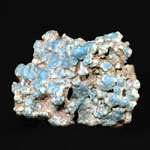




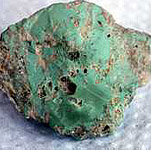

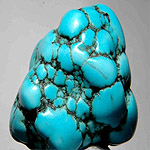
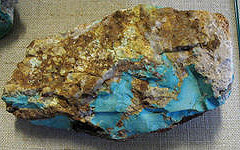


Trade (Kaul, Hawley)
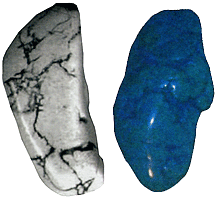 Howlite.
Synonyms: Cowley, silikoborokaltsit. We pay special attention to this natural mineral that today often passes for turquoise. Color natural govlita usually white or gray, often there are minerals with a brown and black veins (the veins resemble veins turquoise). The mineral is named after its discoverer - Canadian geologist Henry Gov. Howlite is borosilicate Ca2B5Si09 calcium (0H) 5. It is a cheap material. The ultraviolet light are tiny, barely visible to the naked eye crystals govlita sometimes glow yellowish or whitish light (these crystals also can be seen in a strong magnifying glass).
Howlite.
Synonyms: Cowley, silikoborokaltsit. We pay special attention to this natural mineral that today often passes for turquoise. Color natural govlita usually white or gray, often there are minerals with a brown and black veins (the veins resemble veins turquoise). The mineral is named after its discoverer - Canadian geologist Henry Gov. Howlite is borosilicate Ca2B5Si09 calcium (0H) 5. It is a cheap material. The ultraviolet light are tiny, barely visible to the naked eye crystals govlita sometimes glow yellowish or whitish light (these crystals also can be seen in a strong magnifying glass).
Howlite easily painted in blue, turquoise, green and any other colors and therefore very often acts as a substitute for turquoise and red or pink corals. It is a natural mineral. Imitation becomes so fine that sellers deliberately give dyed howlite for real turquoise. From govlita cut beads, cabochons, and even small figurines. Polished surface govlita glitters like porcelain (another difference from the turquoise). The main deposits are located in Nova Scotia (Canada). Howlite is found on the territory of California (USA). Turkvenit - kind govlita.
Surface staining govlita very quickly used up. Therefore, we recommend to buy cheap jewelry in the form of beads and pendants from NOT, neoblagorozhennogo white govlita (kaulita), as when it is worn marketable products will not be lost. The beads it is a bit like a turquoise and white intrigue surrounding, retaining an interesting pattern of veins and cracks, and all the advantages of natural stone. Unpainted Kaul sale is not common.
The magical properties of stones.
White govlita symbolizes innocence and at the same time, represents the power of human dignity. Jewellery with govlitom help quell the anger, to banish disturbing thoughts and emotions. There is a belief that brings the howlite restful sleep and helps to remember past dreams. This mineral sharpens the sense of beauty.
Toxic and hazardous radioactive rocks and minerals
** - Poisonous stones and minerals (obligatory check in chemical laboratory + clear indication of toxicity).
** - Radioactive rocks and minerals (obligatory check on a regular dosimeter + ban on the open sale of radioactivity in the event of more than 24 mR / hour + additional measures to protect the population).
All rare stones should always be checked on a regular dosimeter on the permissible level of radiation and a chemical laboratory in the absence of toxic and volatile components which are hazardous to humans and the environment.


Comments
Commenting, keep in mind that the content and the tone of your messages can hurt the feelings of real people, show respect and tolerance to his interlocutors, even if you do not share their opinion, your behavior in terms of freedom of speech and anonymity offered by the Internet, is changing not only virtual, but real world. All comments are hidden from the index, spam control.